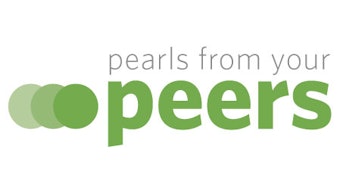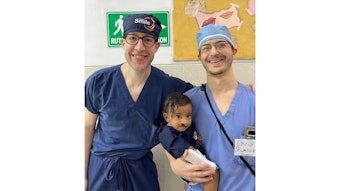Emerging Technologies
AI, telemedicine, and three-dimensional printing hold the potential to transform the practice of medicine.
Christina M. Gillespie, MD, AAO-HNSF Practice Management Education Committee member

Artificial Intelligence
The term artificial intelligence (AI) refers to technology that allows computers to perform tasks that normally require human intelligence.1 AI encompasses two major fields: machine learning and natural language processing. Machine learning algorithms enable computers to learn from data and experiences. There are several distinct types of machine learning algorithms that can be applied to different types of data.
Machine learning has many possible different applications. Applying machine learning algorithms to video data could lead to applications that label important anatomical structures in real time during activities such as sinus surgery or intubation. Machine learning can be used in the clinical setting to help in diagnosis. For example, there is extensive research being conducted in applying AI to the diagnosis of otitis media (OM).2 Currently, the handheld otoscope is the standard of care used to diagnose OM with pneumatic otoscopy increasing diagnostic accuracy. There is extensive current research using machine learning through software applications and diagnostic systems to diagnose OM. Machine learning coupled with a digital otoscope could lead to several robust AI diagnosis tools to help diagnose OM in a variety of practice settings.
Natural language processing is the processing of text or spoken language to make information accessible to computer algorithms. Natural language processing is different from speech recognition. Speech recognition is a well-established technology that enables a computer to identify and interpret words in spoken language and convert them into texts or simple commands. Today, speech recognition tools perform a variety of tasks every day. We talk to our phones, cars, and TV remotes. In medicine, we use Dragon to speak to the electronic medical record.
A virtual (digital) scribe moves beyond mere dictation. A virtual scribe is an automated clinical documentation system able to capture the clinician-patient conversation and then generate the documentation for the encounter.3 A virtual scribe would listen and document the visit into the note using natural language processing. Also, by using machine learning, it could integrate into the note additional clinical information from other places in the chart like labs and radiology reports. There are several companies on the market currently offering AI-based scribing services to physicians, and EMR companies are beginning to integrate such technology into their platforms.
Telemedicine
Telemedicine refers to the use of technology to provide communication and patient care remotely through the transfer of information electronically. During the COVID-19 pandemic, there was an unprecedented adoption and use of telemedicine.4 Telemedicine currently plays a more limited role in otolaryngology due to the inability to fully examine new patients. However, research is being conducted to make telemedicine a more robust option for otolaryngology. A complete otolaryngologic examination relies heavily on objective sources, such as audiograms and otoscopic and endoscopic visualization. Platforms are being developed that allow delivery of information like audiograms, tympanograms, and video otoscopy. Smartphones are also revolutionizing telemedicine. Smartphones can be used in a variety of applications, such as hearing loss screening or voice analysis.5
Three-Dimensional Printing
Three-dimensional printing describes an additive manufacturing process by which objects are formed by gradually layering materials.6 Three-dimensional printing has been used for a variety of surgical applications to include aiding in preoperative discussions, helping surgeons improve understanding of patient-specific anatomy, creating intraoperative implants, and creating surgical guides.7
Three-dimensional printing also plays a role in residency training by creating anatomical models to help trainees acquire needed skills in a wide variety of areas to include sinus surgery, peritonsillar abscess drainage, myringotomy tube placement, and mastoidectomy.8 Research is being conducted in biocompatibility and bioprinting.
We live in exciting times. Technology could help deal with disparate issues such as physician burnout and healthcare inequity. To quote Shakespeare, “Light, seeking light, doth light of light beguile." However, light-assisted technology coupled with newer technology may prove truly enlightening.
References
- Bur AM, Shew M, New J. Artificial Intelligence for the Otolaryngologist: A State of the Art Review. Otolaryngol Head Neck Surg. 2019 Apr;160(4):603-611. doi: 10.1177/0194599819827507.
- Ngombu S, Binol H, Gurcan MN, Moberly AC. Advances in Artificial Intelligence to Diagnose Otitis Media: State of the Art Review. Otolaryngol Head Neck Surg. 2023 Apr;168(4):635-642. doi: 10.1177/01945998221083502.
- Quiroz JC, Laranjo L, Kocaballi AB, Berkovsky S, Rezazadegan D, Coiera E. Challenges of developing a digital scribe to reduce clinical documentation burden. NPJ Digit Med. 2019 Nov 22;2:114. doi: 10.1038/s41746-019-0190-1.
- Holtz BE. Patients Perceptions of Telemedicine Visits Before and After the Coronavirus Disease 2019 Pandemic. Telemed J E Health. 2021 Jan;27(1):107-112. doi: 10.1089/tmj.2020.0168.
- Manning LA, Gillespie CM. E-Health and Telemedicine in Otolaryngology: Risks and Rewards. Otolaryngol Clin North Am. 2022 Feb;55(1):145-151. doi: 10.1016/j.otc.2021.07.011.
- VanKoevering KK, Hollister SJ, Green GE. Advances in 3-Dimensional Printing in Otolaryngology: A Review. JAMA Otolaryngol Head Neck Surg. 2017 Feb 1;143(2):178-183. doi: 10.1001/jamaoto.2016.3002.
- You P, Bartellas M. Three-dimensional Printing in Pediatric Otolaryngology. Otolaryngol Clin North Am. 2022 Dec;55(6):1243-1251. doi: 10.1016/j.otc.2022.07.013.
- de Souza MA, Bento RF, Lopes PT, de Pinto Rangel DM, Formighieri L. Three-dimensional printing in otolaryngology education: a systematic review. Eur Arch Otorhinolaryngol. 2022 Apr;279(4):1709-1719. doi: 10.1007/s00405-021-07088-7.




















